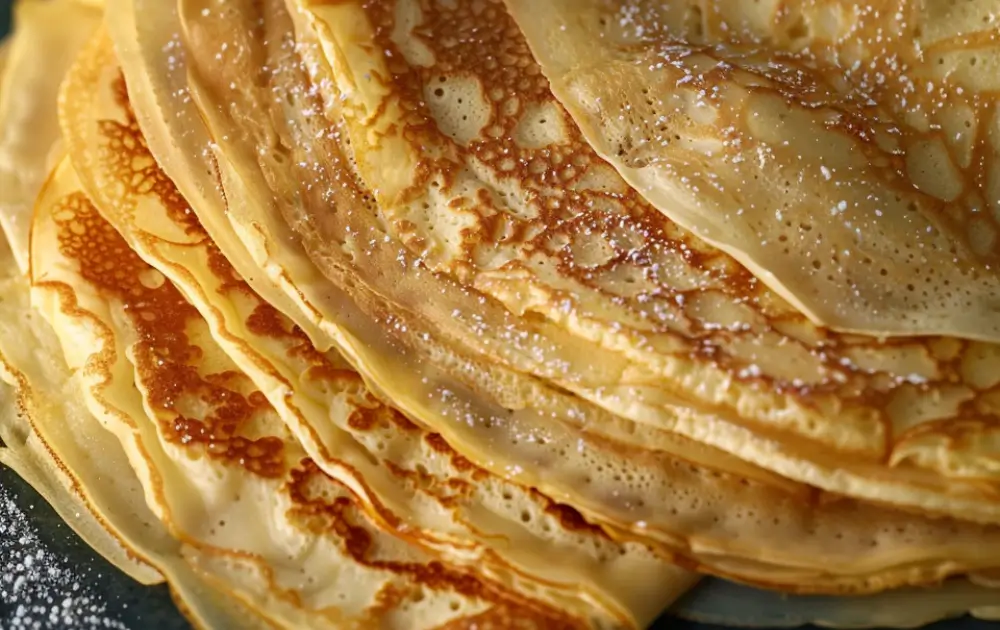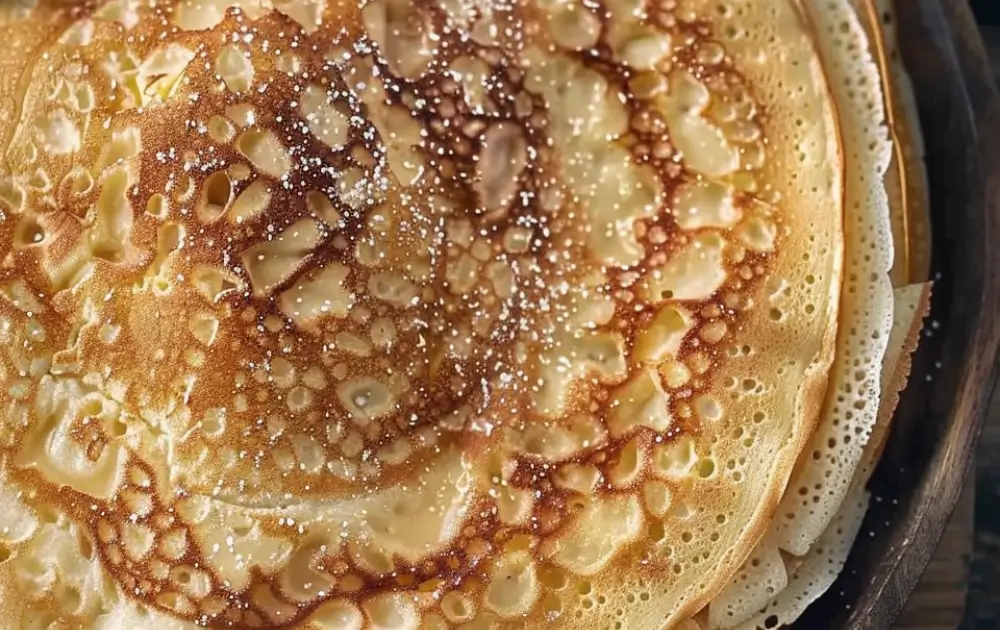Mastering the Art of Simple French Crêpes: A Versatile Delight for Any Meal
Introduction to Simple French Crêpes
Simple French Crêpes are a versatile and beloved dish enjoyed around the world. Originating from France, these thin pancakes are known for their delicate texture and ability to pair with a variety of fillings, both sweet and savory. Made with just a few basic ingredients—flour, eggs, milk, water, and a little butter—crêpes can be dressed up or down to suit any taste or occasion. Whether rolled up with sugar and lemon juice for a simple dessert or filled with ham and cheese for a satisfying meal, crêpes offer a delicious canvas for culinary creativity.

Simple French Crêpes
- Total Time: 55 minutes
- Yield: 12 1x
- Diet: Vegetarian
Description
Simple French Crêpes are thin, light pancakes that offer a versatile base for countless sweet and savory fillings. Perfect for any meal of the day, these crêpes are a staple in French cuisine, known for their delicate texture and elegant simplicity.
Ingredients
- 1 cup all-purpose flour
- 2 large eggs
- 1/2 cup milk
- 1/2 cup water
- 2 tbsp melted butter
- A pinch of salt
- Optional: Sugar or vanilla extract for sweet crêpes
Instructions
- Mix Dry Ingredients: In a large mixing bowl, sift together the flour and salt. Add sugar if making sweet crêpes.
- Combine Wet Ingredients: In another bowl, whisk together the eggs, milk, water, and melted butter. If desired, add vanilla extract for sweet crêpes.
- Make Batter: Pour the wet ingredients into the dry ingredients and whisk until the batter is smooth and free of lumps. For the best results, strain through a fine sieve.
- Rest the Batter: Cover the bowl and let the batter sit for at least 30 minutes at room temperature to allow the flour to absorb the liquids fully.
- Cook: Heat a non-stick frying pan over medium heat. Lightly grease with butter or oil. Pour about 1/4 cup of batter into the pan, tilting to spread evenly. Cook for about 2 minutes until the bottom is light golden, then flip and cook the other side for 1 minute.
Notes
- Resting the batter is crucial for developing the texture and flavor.
- Ensure the pan is hot before pouring the batter to get thin, even crêpes.
- Adjust the amount of batter and cooking time based on the size of your pan
- Prep Time: 10 minutes
- Cook Time: 15 minutes
- Category: Breakfast, Dessert
- Method: Frying
- Cuisine: French
Nutrition
- Calories: 115
- Sugar: 2g
- Sodium: 90mg
- Fat: 4.5g
- Carbohydrates: 15g
- Protein: 3g
- Cholesterol: 48mg
Frequently Asked Questions about Crêpes
- What’s the difference between a crêpe and a pancake? Crêpes are much thinner and lighter than pancakes and do not contain a leavening agent like baking powder that causes pancakes to rise.
- Can crêpe batter be made in advance? Yes, you can prepare crêpe batter ahead of time and refrigerate it for up to 48 hours. Resting the batter allows the flour to fully absorb the liquid and improves the texture of the crêpes.
- Are crêpes only for breakfast? No, crêpes are incredibly versatile and can be adapted for any meal, including lunch, dinner, and dessert, depending on the fillings and toppings used.
- Can crêpes be made gluten-free? Absolutely! You can substitute the all-purpose flour with gluten-free flour blends to accommodate dietary restrictions without compromising on taste or texture.
- What are some common mistakes when making crêpes? Common mistakes include using batter that is too thick, which leads to heavy crêpes, and cooking at the wrong temperature, which can cause the crêpes to either burn or be undercooked.
Ingredients and Their Roles
The beauty of crêpes lies in their simplicity. All-purpose flour forms the base of the batter, providing structure. Eggs contribute to the richness and color, binding the ingredients together. Milk and water are mixed to create a thin, fluid batter that spreads easily across the pan, ensuring the crêpes are light and tender. Melted butter adds a subtle flavor and helps in browning the crêpes as they cook. For sweet crêpes, a dash of sugar or a splash of vanilla extract can be added to the batter, enhancing the flavor with a sweet aroma.
Preparation Techniques
Preparing crêpe batter is straightforward but requires attention to detail to achieve the perfect consistency. Start by whisking the flour and salt in a large bowl. In a separate bowl, mix the eggs, milk, water, and melted butter. Gradually add the liquid ingredients to the dry, whisking continuously to prevent lumps. For the smoothest texture, some cooks prefer to strain the batter or let it rest for an hour, allowing the flour to fully hydrate and the gluten to relax, which makes the crêpes more tender. Once the batter is ready, it should be the consistency of heavy cream.
Cooking Method and Tips
Cooking crêpes requires a good non-stick skillet or a special crêpe pan that is heated over medium heat. Lightly grease the pan with butter, then pour a small amount of batter into the center, swirling the pan immediately to spread the batter thinly and evenly. Cook each crêpe for about one minute, until the edges lift from the pan and the bottom is lightly golden. Flip it carefully with a thin spatula to cook the other side. The key is to maintain a consistent temperature and quickly rotate the pan to spread the batter. Stack the cooked crêpes on a plate, placing parchment paper between them to prevent sticking.
Serving Suggestions
French crêpes are incredibly versatile in their serving options. For a simple breakfast, fill them with fresh fruit and a dollop of yogurt or whipped cream. Sweet crêpes can be enjoyed with a sprinkle of sugar and lemon juice, or topped with chocolate sauce and sliced bananas. Savory variations might include fillings like sautéed mushrooms, spinach, and cheese, or smoked salmon with cream cheese. Crêpes can be folded into quarters, rolled up, or even stacked with layers of filling for a decadent treat. Serve immediately while warm to enjoy their full flavor and texture.
Customization Ideas for Various Occasions
Crêpes offer endless customization options that can suit any occasion, from elegant brunches to casual snacks. For a festive brunch, consider offering a crêpe bar with assorted fillings like blueberry compote, maple syrup, and nutella, allowing guests to choose their favorites. For a more refined dessert, crêpes can be layered with pastry cream and berries to create a sophisticated mille-crêpe cake. During the holidays, spice up the batter with cinnamon or pumpkin spice and fill with stewed apples for a festive twist. For a savory dinner, fill crêpes with a mixture of goat cheese, spinach, and sun-dried tomatoes for a satisfying meal.
Nutritional Benefits and Dietary Adaptations
While traditional crêpe recipes are not particularly high in nutrients, they can be adapted to fit various dietary needs and preferences. Using whole wheat or buckwheat flour instead of all-purpose flour enhances the fiber content and adds a nuttier flavor. For those on a gluten-free diet, gluten-free flour blends can be used without compromising texture or taste. Adding protein-rich fillings like cottage cheese or scrambled eggs can transform a simple crêpe into a more balanced meal. Moreover, using non-dairy milk and vegan butter makes the recipe suitable for vegan diets, ensuring everyone can enjoy this delightful dish.
Advanced Cooking Techniques
For those looking to perfect their crêpe-making skills, mastering a few advanced techniques can elevate the simple dish to restaurant quality. Using a proper crêpe spreader can help achieve an ultra-thin consistency, essential for authentic French crêpes. Experimenting with the batter’s resting time can also affect the final product; a longer rest can result in a more cohesive and tender crêpe. For a dramatic presentation, flambé crêpes with a splash of liquor such as Grand Marnier to create the famous Crêpes Suzette. Practicing the flip can also ensure your crêpes are cooked evenly without tearing.
Incorporating Seasonal Ingredients
Utilizing seasonal ingredients in crêpes not only enhances flavor but also connects the dish with the time of year. In spring, fill crêpes with lemon curd and fresh strawberries for a bright, fresh dessert. Summer crêpes can feature an assortment of stone fruits like peaches and cherries, possibly with a hint of basil or mint for freshness. Autumn calls for fillings of caramelized apples, pears, or pumpkin spice cream. In winter, rich chocolate sauces, preserved fruits, or spiced compotes make for comforting fillings that warm the spirit.
Exploring International Variations
Crêpes are enjoyed worldwide and exploring international variations can provide a new appreciation for this versatile dish. In Eastern Europe, crêpes known as blintzes are filled with cottage cheese or meat and then fried or baked. Italian crespelle might be filled with ricotta and spinach, then baked with marinara and mozzarella on top. In Japan, street vendors make Hiroshima-style okonomiyaki, which are savory crêpes loaded with cabbage, seafood, or pork and topped with a variety of condiments. Exploring these international flavors can inspire new creations and broaden the traditional crêpe repertoire.
Healthier Alternatives for Crêpe Ingredients
Opting for healthier alternatives in crêpe recipes can make this delightful dish suitable for various health-conscious diets. Substitute refined all-purpose flour with whole grain options like buckwheat or oat flour to increase the nutritional content, including fiber. For those reducing sugar intake, sweeten the batter naturally with mashed bananas or pureed dates instead of adding sugar, enhancing the flavor while keeping it wholesome. Use almond milk or coconut milk as a dairy-free alternative to regular milk, which not only caters to those with dairy restrictions but also adds a subtle nutty or tropical flavor to the crêpes. Additionally, incorporating egg whites instead of whole eggs can reduce the fat content while still providing a fluffy texture to the batter.
Creative Presentation Techniques for Serving Crêpes
Presenting crêpes in creative and appealing ways can enhance the dining experience, making simple meals feel special. For a visually stunning breakfast, stack crêpes with layers of yogurt and fresh fruits to create a crêpe cake, garnishing with a drizzle of honey and chopped nuts. Offer mini crêpe rolls filled with various sweet and savory fillings as appetizers or party snacks, allowing guests to enjoy a diverse range of flavors in bite-sized portions. For a dessert that doubles as a showstopper, present crêpes folded into triangles and topped with a scoop of gelato, drizzled with chocolate or fruit sauces. Utilizing edible flowers and colorful fruit slices as garnishes can also elevate the aesthetic appeal of your crêpe dishes.
Seasonal and Festive Crêpe Ideas
Aligning crêpe fillings and toppings with seasonal and festive themes can make them a highlight of any celebration. In the autumn, incorporate pumpkin spice into the batter and serve with a side of warm apple cider compote for a cozy treat. During the holiday season, crêpes can be filled with minced pies filling or gingerbread-spiced cream, offering a festive twist that complements traditional desserts. For Valentine’s Day, chocolate and strawberry-filled crêpes can make for a romantic breakfast or dessert. During summer, top crêpes with a lemon-infused cream and fresh berries for a refreshing and light treat suitable for warmer weather.
Tips for Making Crêpes with Kids
Making crêpes can be a fun and educational activity to enjoy with children, teaching them basic cooking skills while engaging their creativity. Start by letting kids help with measuring and mixing the ingredients, which can enhance their math skills and understanding of food science. Allow them to choose their own fillings, whether it’s chocolate spread, whipped cream, or sliced fruits, giving them a sense of independence and personalization. Supervise them as they learn to swirl the pan to spread the batter, which can be a thrilling experience for young chefs. Finally, decorate the crêpes together with colorful toppings, turning mealtime into a playful art project that they can eat!
Utilizing Crêpes in Gourmet Dining
Crêpes have a place in gourmet dining as they can be elevated with high-quality, sophisticated ingredients. Fill crêpes with gourmet cheeses like Brie or Gorgonzola and pair with fig jam or honey for a luxurious appetizer. For main courses, consider filling crêpes with lobster, crab, or high-quality smoked salmon, accompanied by delicate sauces such as saffron-infused creams or dill beurre blanc. In fine dining desserts, crêpes can be paired with exquisite toppings like caviar, truffle oil, or gold leaf. These refined variations not only showcase the versatility of crêpes but also cater to an upscale dining experience, making them a versatile choice for chefs and restaurateurs.
Incorporating Superfoods into Crêpe Recipes
Elevate the nutritional value of your crêpes by incorporating superfoods into the recipes. Blend spinach or kale into the batter to create vibrant green crêpes packed with vitamins and minerals. For a boost of antioxidants, add acai powder or ground flaxseeds, which can subtly enhance the flavor while contributing essential omega-3 fatty acids. Use quinoa flour as a high-protein, gluten-free alternative to traditional flours, offering a nutty flavor and a boost of complete protein. Sprinkle chia seeds or hemp seeds into the batter for added texture and a significant increase in dietary fiber and protein, making your crêpes not only delicious but also exceptionally healthy.
Professional Chef Techniques for Perfect Crêpes
For culinary professionals looking to perfect their crêpe-making skills, focusing on technique can make all the difference. Use a well-seasoned or non-stick crêpe pan to ensure smooth cooking without sticking. Control the heat carefully; too hot, and the crêpes will burn before cooking through—too cool, and they won’t develop that delightful, light brown crispiness. Practice the wrist motion required to spread the batter thinly and evenly—it’s the key to achieving the classic, paper-thin consistency of a perfect crêpe. Lastly, consider using clarified butter for cooking crêpes, as it can withstand higher cooking temperatures without burning, providing a delicious, buttery flavor without the risk of smoking.
Eco-Friendly Cooking and Serving Suggestions
Embrace eco-friendly practices in your crêpe preparation and presentation to appeal to environmentally conscious diners. Source local and organic ingredients to reduce your carbon footprint and support local agriculture. Use reusable cloths and eco-friendly utensils for preparation and serving, minimizing waste. Serve crêpes on biodegradable or compostable plates if disposables are necessary, and pair them with wooden cutlery. Additionally, implement a composting system for any organic waste produced during the cooking process, such as egg shells and fruit peels, contributing to a more sustainable kitchen environment.
Pairing Crêpes with Artisanal Beverages
Complement your crêpe dishes with artisanal beverages for a full dining experience. Pair sweet crêpes with high-quality dessert wines such as Moscato or a late-harvest Riesling, which can accentuate the sweetness and fruitiness of the crêpes. For savory crêpes, offer craft beers, such as a crisp Pilsner or a light IPA, that can cut through the richness of fillings like cheese and meat. Artisanal coffee or tea selections can also enhance the crêpe-eating experience; for example, a robust espresso or a delicate white tea can be the perfect finish to a crêpe meal, providing a balance in flavor and sophistication.
Marketing Crêpes for Special Dietary Needs
Tailor your crêpe offerings to meet specific dietary needs, enhancing your menu’s appeal to a broader audience. Develop gluten-free crêpe options using buckwheat or rice flour, which are naturally gluten-free yet still offer the desired texture and flavor. Create vegan crêpe variations by substituting eggs and dairy with almond milk, soy yogurt, and flaxseed mixtures, catering to the vegan market. For those monitoring their sugar intake, prepare sugar-free crêpes using natural sweeteners like stevia or erythritol. Promote these special dietary options through your restaurant’s marketing channels, emphasizing your commitment to accommodating various health and lifestyle choices, thereby attracting health-conscious customers.
Conclusion
Simple French Crêpes offer a delightful and flexible option for any meal, drawing on their rich culinary tradition while allowing for creativity with modern twists. Whether you prefer them sweet or savory, these thin pancakes provide a perfect canvas for a variety of ingredients, making them a favorite in culinary traditions around the world. By mastering the basic technique and experimenting with different fillings and presentations, you can elevate simple crêpes into an exquisite meal that impresses all who try them. Embrace the versatility of crêpes and enjoy crafting unique and delicious creations that showcase your culinary skills.




